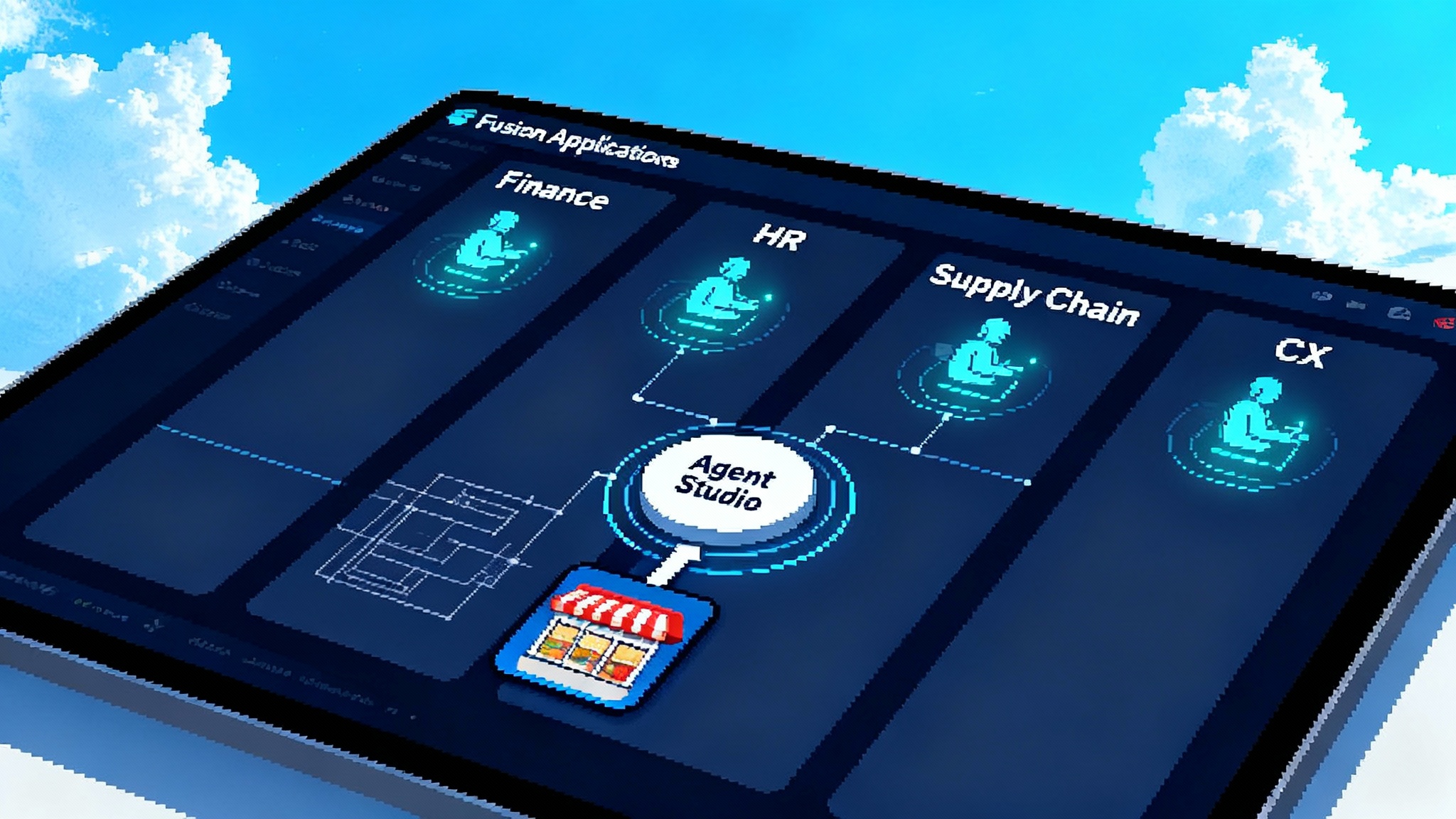Gemini Enterprise turns Workspace into a multi-agent OS
Google quietly rewired Workspace in October 2025. Gemini Enterprise is not a smarter chat box but governed multi agent workflows across Docs, Sheets, Gmail, and even Slack. See what changed, why it matters, and how to pilot it safely.

The news: Google flips the switch on agents
On October 9, 2025, Google folded its Agentspace experience into a product it now simply calls Gemini Enterprise. Buried in the announcement was a strategic pivot. Workspace is being wired so agents can work together, move across apps, and follow rules that administrators can see and control. This is less about a friendlier chatbot and more about turning Workspace into a governed automation plane. You can see the shift in the official Gemini Enterprise release notes.
At Google I O in May, the company previewed Agent Mode and Project Mariner. Agent Mode lets you delegate multi step tasks that an agent can carry out on your behalf. Project Mariner is Google’s autonomous web browsing agent that can go beyond a single query and execute a series of steps, like finding an apartment across multiple sites, applying filters, and collecting results. Five months later, the October product naming and admin updates show the company is moving from chat first to workflow first.
Why this is a platform shift, not a chatbot upgrade
The last two years were dominated by copilots that sat in a sidebar and suggested text. Useful, yes, but limited. Copilots answer questions. Agents execute. Gemini Enterprise repositions the center of gravity by making the Workspace fabric itself agent aware. That means:
- Actions can span Docs, Sheets, Slides, Drive, Gmail, Calendar, Keep, and Tasks without constant copy paste.
- Custom Gems, which are tailored versions of Gemini, can live directly in the side panels of Workspace apps.
- Partner agents can be invited into a workflow so work that starts in Gmail can continue in Slack or a ticketing tool without human relay.
If that sounds like mission control for enterprise work, it is. We have seen other platforms move in this direction. Salesforce is turning CRM into the control plane for agents, as we discussed when we covered CRM as the control plane. Google’s move brings that philosophy to the most universal suite in the enterprise.
What Agent Mode and Project Mariner actually do
Think of Agent Mode as a command center and Mariner as a web capable scout. They do different jobs that compound when combined.
Agent Mode
- You state a goal and a preferred outcome. The agent plans steps, asks for permissions when needed, and executes.
- Under the hood, Agent Mode tracks state, remembers intermediate results, and decides when to call Workspace actions or third party services.
- It is designed to ask for confirmation at the right time, like before sending email to a distribution list or before writing to a sensitive Sheet.
Project Mariner
- Mariner brings a web capable agent into the mix. It can follow links, extract structured data, and loop until an objective is met.
- Expect Mariner to appear first in Search Labs and in the Gemini app, then to surface as a callable capability inside Workspace contexts.
Together, you get orchestrated behavior. A planner agent can break a task into parts, a researcher can read and extract, a writer can draft, and an actuator can update apps. The output is a coordinated sequence, not just a block of suggested text.
What you can pilot this quarter
Here are capabilities most organizations can test now, with examples you can run in an hour, not a quarter.
1) Cross app actions become table stakes
- Ask in the Gemini app to collect all customer rollout dates from Gmail threads, summarize the risk items from linked Docs, and create a Sheet with owners and deadlines. The agent uses Workspace apps access and logs each hop.
- From Calendar, ask Gemini to create events and tasks based on a planning Doc. The agent writes to Calendar and Tasks so the plan becomes a schedule, not just a document.
2) Custom Gems move into side panels
- A sales operations team can dock a Pricing Coach Gem inside Gmail and Docs. The Gem reads a shared playbook in Drive, enforces the latest discount rules, and drafts replies that conform to regional guidelines. Because the Gem runs inside Workspace, it inherits access controls and audit trails.
- A research team can keep a Literature Scout Gem in Docs. Paste a problem statement, have the Gem assemble a reading list from Drive, and summarize each source into a one pager in the same document. If it needs data from Sheets, it can pull that too.
3) Partner agents show up where people already work
- A lead hits your site, the CRM agent starts qualification, then Gemini in Gmail prepares a personalized reply while a Slack thread spins up with the account team. Each step is agent to agent, with humans in the loop to approve key actions.
- In support and IT, partner agents can open tickets, look up knowledge articles, and post updates into Slack or Chat while Gemini drafts customer responses in Gmail and updates a troubleshooting runbook in Docs.
4) Ask Gemini in Meet fills knowledge gaps live
- During a Meet call, a product manager asks Gemini to pull the latest adoption numbers from a Sheet and paste a slide into the deck in progress. The agent cites the source, writes the slide, and saves a version of the deck. Everyone sees what changed.
If you are building your own agents, the principles in our deep dive on governed shippable agents will map cleanly to Gemini Enterprise’s staged output and audit patterns.
The guardrails that matter: permissions, telemetry, rollback
If agents can act, governance must keep up. There are three layers worth getting right from day one.
1) Permissions
- Scope access through Workspace apps in the Gemini app. Admins can turn these on or off at the organizational unit or group level, and control whether agents can read from Gmail, Drive, Docs, Calendar, Keep, and Tasks. The safest pattern is least privilege by default, then grant necessary scopes to specific teams.
- Treat partner agents like any other app. Use OAuth consent screens, review scopes, and require admin approval before a third party agent can act on behalf of users.
2) Telemetry
- Use the Reporting API and audit tools to see exactly when an agent accessed a Drive file, summarized an email thread, or created a Calendar event. Pull usage by user, app, and feature, and export it to your security information and event management system.
- For eDiscovery, Workspace Vault can retain Gemini chats, which means prompts and responses are discoverable like email. That is a feature, not a bug, because it drives responsible use and simplifies compliance reviews.
3) Rollback
- In Docs and Sheets, version history is your rollback. Require agents to suggest or stage changes in a draft document, then have a human accept tracked edits. If something goes off course, restore the previous version.
- In Gmail, the agent should draft, not auto send, for sensitive workflows. In Slack or Chat, require human approval on messages that change records or commit to customers.
- For multi step runs, adopt a playbook pattern. Each step writes an artifact you can inspect, like a saved query, a draft reply, or a Sheet update. If step three fails a check, you can revert steps one and two without guessing what changed.
Under the hood: why this is a multi agent turn
The old pattern was a single model with a library of tools. That works for simple tasks but breaks down when a workflow crosses apps, involves repetitive subproblems, and requires governance. Gemini Enterprise is moving to a pattern where:
- You compose several specialized agents. A planner breaks the task. A researcher reads and extracts. A writer drafts. An actuator updates apps. Each has narrow responsibilities and clear permissions.
- The system tracks state and provenance. Every action leaves a trail so you can explain how a draft was produced, by whom, using which sources.
- Admins set policy centrally. Scopes, data boundaries, and logging are configured once, then enforced wherever agents run, from the Gemini app to side panels in Docs or Gmail.
This is how you go from smart autocomplete to an enterprise automation plane.
Interop is coming: MCP and agent to agent standards
Open interop is the accelerator. In October, Google completed a shift in Gemini Code Assist that matters far beyond coding. Tools were deprecated in favor of Agent Mode, and connections now route through the Model Context Protocol, often shortened to MCP. MCP is a vendor neutral standard for connecting models to tools and data sources. You can see the change in the Code Assist release notes.
Why it matters:
- MCP paves the way for interchangeable connectors. If your procurement policy demands that customer data never leave a specific region or cloud, you can point agents to an MCP server that enforces that policy.
- Cross vendor collaboration becomes more realistic. Agents running in different ecosystems can talk to the same data and tools with consistent controls. That reduces integration cost and audit complexity.
- An agent to agent protocol, often shortened to A2A, is the logical next step. Today, partner agents integrate through app specific adapters. A2A would let a CRM agent negotiate a handoff with a Gemini agent in a standard way. Describe intent, confirm scope, share a minimal plan, and request approval, all with signatures the audit system can verify.
If you are exploring how agents will run outside your core cloud, our analysis of an edge runtime for agents shows why portability will matter as MCP spreads.
How to run a disciplined 30 day pilot
You do not need a twelve month program. You need a focused four week sprint that uses real work, real guardrails, and clear metrics.
Week 1: scope and safety
- Pick two workflows that cross at least three apps. Good candidates are new customer onboarding and quarterly business review preparation.
- Define success in numbers. Minutes saved, response time improved, defects avoided.
- Turn on Workspace apps access for a small group. Restrict scopes to what the pilot needs. Enable logging, audit, and Vault retention for Gemini activity.
Week 2: compose agents and stage outputs
- Create two or three Gems per workflow. Name them by role, not by person. For example, Briefing Researcher, Drafting Editor, and Calendar Scheduler.
- Stage outputs. Require agents to produce drafts in Docs, tables in Sheets, and scheduled items in Calendar that humans can accept or reject. No auto sends.
Week 3: integrate partner agents
- Wire a partner agent to the conversation surface your team already lives in. For sales or support, that is often Slack. Start with read only posts that summarize and link to drafts in Docs or Gmail. Add action buttons only after a signoff path is clear.
- Document a two step rollback for each action. If a message is posted or a Sheet is updated, specify how to revert, who can do it, and where the log lives.
Week 4: measure and decide
- Pull audit logs and usage metrics. Did agents stay within scopes. Which actions fired most often. Where did humans intervene.
- Compare time saved and error rates to your baseline. Decide whether to expand, pause, or redesign the workflow. If you expand, keep the staged output pattern until the acceptance rate is consistently high.
Scorecard: how to know it is working
Use a simple scorecard to separate novelty from value.
- Adoption. Share of pilot users who run at least one agent action per day. Target 60 percent by week four.
- Velocity. Average cycle time from goal to approved output. Target a 30 percent reduction from baseline.
- Quality. Human acceptance rate for staged outputs. Target 85 percent or higher by the end of the pilot.
- Safety. Zero unsanctioned sends or writes. Confirm via audit logs and spot checks.
- Reusability. Count of Gems and prompts that are promoted from experiment to template. Target at least three per workflow.
What to watch through mid 2026
- Native Agent Mode inside every Workspace surface. The practical test is simple. Can a user assign a goal from anywhere and have the agent decide where to act without context switching.
- Partner agents that respect enterprise boundaries by default. Look for connectors that honor data residency, role based access control, and encryption out of the box, not as an upsell.
- MCP everywhere and early A2A proofs. Vendors will push registries of vetted connectors, with signed manifests and predictable scopes. Security teams should be ready with standard reviews and a small set of approved templates.
- Stronger admin tooling. Expect prebuilt policies like never auto send external email or stage Sheets changes for approval that you can toggle for specific groups. The more policy becomes a setting rather than a playbook, the safer broad deployment becomes.
Bottom line
October’s changes are not just a new label. Gemini Enterprise is quietly turning Workspace into an operating system for agents. The shift from single copilots to multi agent, governed workflows will feel incremental at first, like better side panels and smarter drafts. Then one day soon a plan you assign in Gmail will materialize as a set of calendar invites, a populated spreadsheet, a polished brief, and a coordinated Slack thread, each step logged, permissioned, and reversible.
If you are a leader, your job is to move that day closer and keep it safe. Start small, stage outputs, measure everything, and insist on standards. The future of enterprise productivity will be built by agents that can work together and prove what they did. That future is starting inside Workspace, and it is arriving faster than most roadmaps assume.








